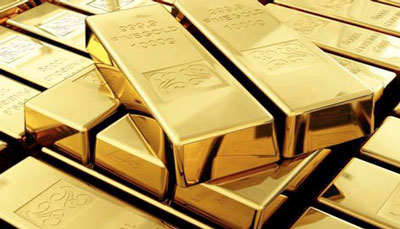Gold Price History: The Last 2000 Years

It really is no exaggeration to say that human beings have valued gold for as long as they’ve been able to get their hands on it. Burial sites going back to the 4th millennium BC include skillfully wrought gold artifacts, and weights of gold were used in commerce well before the Lydians started minting coins around 600 BC.
That’s not to say that gold has held a steady value throughout that time. Inflation is by no means a modern concept, and gold prices have been surprisingly volatile throughout history. Some of this can be tied to scarcity; only about 171,000 metric tons of gold have been mined in all of human history up to 2011 (by way of comparison, Brazilian iron ore miner Vale (VALE) produced 323 million tons of iron ore in 2011 alone). Consequently, expanding and shrinking economies have always found themselves chasing a relatively small (and, for long stretches of time, nearly static) supply of gold.
Ancient Times
It’s inherently difficult to translate ancient values of gold and silver into modern terms. Many of the records and sources that discuss prices talk in terms of mercenaries and slaves – commerce that is very difficult to relate to modern terms. Nevertheless, a few attempts at relating the value of gold can be made.
The Greek gold “talent” weighed about 26 kg or 829 troy ounces – an amount worth about $1.4 million at current gold prices. A talent of silver would pay a skilled craftsman’s wages for nine years, while a gold talent would pay for 270 years of such work. At $20 per hour in modern terms, that would be worth approximately $13.5 million.
As another example, a laborer would earn about one drachma per day in the fifth century, or 0.004 troy ounces of gold (about $8 in today’s money); by 377 BC, the pay had increased to two and a half drachmae ($20 in today’s money). To add a little extra context, ancient sources indicate that a drachma would buy 3 kilos of olive oil in the fifth century – about $9 or $10 today.
While the Romans took record-keeping to new levels, here too it is challenging to translate prices into modern equivalents. Nevertheless, a few data points are available. A craftsman in Rome in the first century BC could make 12 ases in a day – about four grams of silver, or about $4.
Romans also seemed to pioneer inflation and debasement. Augustus established a gold standard in 30 BC, but that lasted only about 100 years. Nero reduced the weight of the denarius by 4% and the silver content by about 5% (to 93.5%), and 200 years later the denarius was only 40% silver. From the beginning to the end of the second century, a “measure” of wheat went from 7 or 8 drachmae (historians often converted denarii back to drachmae) to 120,000. Likewise, emperor Diocletian attempted to fix the value of one pound of gold at 50,000 denarii in 301 AD, but by 324 AD the exchange rate was 300,000 to one pound and the rate jumped to 2.1 billion per pound by the mid-4th century.
Middle Ages
Inflation continued to follow an erratic path after the ancient/classical periods. Rulers would debase the currency (essentially inflating the economy) to pay for wars, while large-scale depopulation from war and disease would often create strong deflationary pressures.
A few anecdotes are worth noting. When Mansa Musa made his famous pilgrimage to Mecca in 1324, his retinue was reportedly carrying upwards of 32,000 pounds of gold. So profligate was Mansa Musa that he alone inflated the economies of Cairo, Medina, and Mecca for years to come – changing the price of gold by about 12% in Cairo.
Modern Era
While some governments adopted fractional gold standards during World War I to help finance their war efforts through inflation, gold prices stayed surprisingly stable in the early 20th century despite the chaos and carnage of two world wars. From a price of about $18.92 in 1910, gold moved to $20.68 in 1920, $20.65 in 1930, and $33.85 in 1940. Post-World War II, gold spent most of the next quarter-century in a narrow range around $35.
Starting in 1968, the fixed gold standard began to crumble. That year, a two-tier system began that allowed gold to float in private trading but maintain a fixed price for central banks. The central banks (particularly the U.S.) could not afford to maintain this, though, and the fixed system collapsed entirely in 1971.
Prices quickly reacted. From a 1967 price of $34.95 per ounce, gold rose to $39.31 in 1968, $40.62 in 1971, and $154 in 1974. Gold prices would ultimately peak at over $600 per ounce in 1980 before retreating into the $300s for most of the 1980s and 1990s. After dipping below $275 an ounce in 2001, gold rebounded fiercely throughout the decade and hit an all-time high of approximately $1,900 an ounce in 2011.
To offer a little context to this price increase, Henry Ford revolutionized American industry when he moved worker wages to $5 a day in 1914 (a little more than a quarter-ounce of gold). Today, at the federal minimum wage of $7.25, a day’s work would pay $58, or only about 3% of an ounce of gold. However, this isn’t an entirely fair comparison: Ford’s wages were well above the standard of the day when autoworkers made about $2.34 per day on average. But it does show how gold values can change dramatically over relatively short periods of time.
The Future
The history of the value and price of gold is one of predictable unpredictability. As things stand today, it seems hard to imagine that national governments are going to abandon pro-inflationary policies that essentially devalue money. At the same time, gold supplies are not likely to increase significantly, which suggests further appreciation in the price of gold. By the same token, economic revolutions tend to come suddenly and with little warning. A return to a tighter monetary policy could significantly undercut the value of gold at some point in the future.
Source: CommodityHQ – Gold Price History: The Last 2000 Years




























